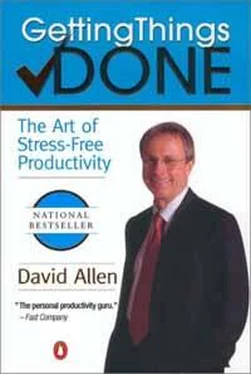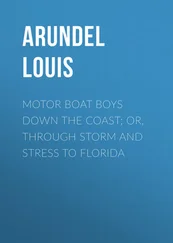It can be daunting to capture into one location, at one time, all the things that don't belong where they are. It may even seem a little counterintuitive, because for the most part, most of that stuff was not, and is not, "that important"; that's why it's still lying around. It wasn't an urgent thing when it first showed up, and probably nothing's blown up yet because it hasn't been dealt with. It's the business card you put in your wallet of somebody you thought you might want to contact sometime. It's the little piece of techno-gear in the bottom desk drawer that you're missing a part for. It's the printer that you keep telling yourself you're going to move to a better location in your office. These are the kinds of things that nag at you but that you haven't decided either to deal with or to drop entirely from your list of open loops. But because you think there still could be something important in there, that "stuff" is controlling you and taking up more psychic energy than it deserves. Keep in mind, you can feel good about what you're not doing, only when you know what you're not doing.
So it's time to begin. Grab your in-basket and a half-inch stack of plain paper for your notes, and let's . . .
... Go!
Physical Gathering
The first activity is to search your physical environment for anything that doesn't belong where it is, the way it is, permanently, and put it into your in-basket. You'll be gathering things that are incomplete, things that have some decision about potential action tied to them. They all go into "in," so they'll be available for later processing.
Train yourself to notice and collect anything that doesn't belong where it is forever
What Stays Where It Is
The best way to create a clean decision about whether something should go into the in-basket is to understand clearly what shouldn't go in. Here are the four categories of things that can remain where they are, the way they are, with no action tied to them:
• Supplies
• Reference material
• Decoration
• Equipment
Supplies . . . include anything you need to keep because you use it regularly. Stationery, business cards, stamps, staples, Post-it pads, legal pads, paper clips, ballpoint refills, batteries, forms you need to fill out from time to time, rubber bands—all of these qualify. Many people also have a "personal supplies" drawer at work containing dental floss, Kleenex, breath mints, and so on.
Reference Material ... is anything you simply keep for information as needed, such as manuals for your software, the local take-out deli menu, or your kid's soccer schedule. This category includes your telephone and address information, any material relevant to projects, themes, and topics, and sources such as dictionaries, encyclopedias, and almanacs.
Decoration . . . means pictures of family, artwork, and fun and inspiring things pinned to your bulletin board. You also might have plaques, mementos, and/or plants.
Equipment ... is obviously the telephone, computer, fax, printer,wastebasket, furniture, and/or VCR.
You no doubt have a lot of things that fall into these four categories—basically all your tools and your gear, which have no actions tied to them. Everything else goes into "in." But many of the things you might initially interpret as supplies, reference, decoration, or equipment could also have action associated with them because they still aren't exactly the way they need to be.
For instance, most people have, in their desk drawers and on their credenzas and bulletin boards, a lot of reference materials that either are out of date or need to be organized somewhere else. Those should go into "in." Likewise, if your supplies drawer is out of control, full of lots of dead or unorganized stuff, that's an incomplete that needs to be captured. Are the photos of your kids current ones? Is the artwork what you want on the wall? Are the mementos really something you still want to keep? Is the furniture precisely the way it should be? Is the computer set up the way you want it? Are the plants in your office alive? In other words, supplies, reference materials, decoration, and equipment may need to be tossed into the in-basket if they're not just where they should be, the way they should be.
Issues About Collecting
As you engage in the collecting phase, you may run into one or more of the following:
• you've got a lot more than will fit into one in-basket;
• you're likely to get derailed into purging and organizing;
• you may have some form of stuff already collected and organized; and/or
• you're likely to run across some critical things that you want to keep in front of you.
What If an Item Is Too Big to Go in the In-Basket? If you can't physically put something in the in-basket, then write a note on a piece of letter-size plain paper to represent it. For instance, if you have a poster or other piece of artwork behind the door to your office, just write "Artwork behind door" on a letter-size piece of paper and put the paper in the in-basket.
Be sure to date it, too. This has a couple of benefits. If your organization system winds up containing some of these pieces of paper representing something else, it'll be useful to know when the note was created. It's also just a great habit to date everything you hand-write, from Post-it notes to your assistant, to voice-mails you download onto a pad, to notes you take on a phone call with a client. The 3 percent of the time that this little piece of information will be extremely useful makes it worth developing the habit.
What If the Pile Is Too Big to Fit into the In-Basket? If you're like 98 percent of my clients, your initial gathering activity will collect much more than can be comfortably stacked in an in-basket. If that's the case, just create stacks around the in-basket, and maybe even on the floor underneath it. Ultimately you'll be emptying the in-stacks, as you process and organize everything. In the mean-time, though, make sure that there's some obvious visual distinction between the stacks that are "in" and everything else.
Instant Dumping If it's immediately evident that something is trash, go ahead and toss it when you see it. For some of my clients, this marks the first time they have ever cleaned their center desk drawer!
If you're not sure what something is or whether it's worth keeping, go ahead and put it into "in." You'll be able to decide about it later, when you process the in-basket. What you don't want to do is to let yourself get wrapped up in things piece by piece, trying to decide this or that. You'll do that later anyway if it's in "in," and it's easier to make those kinds of choices when you're in processing mode. The objective for the collection process is to get everything into "in" as quickly as possible so you've appropriately retrenched and "drawn the battle lines."
Be Careful of the Purge-and-Organize Bug! Many people get hit with the purge-and-organize virus as they're going through various areas of their office (and their home). If that happens to you, it's OK, so long as you have a major open window of time to get through the whole process (like at least a whole week ahead of you). Otherwise you'll need to break it up into chunks and capture them as little projects or actions to do, with reminders in your system, like "Purge four-drawer cabinet" or "Clean office closet." What you don't want to do is let yourself get caught running down a rabbit trail cleaning up some piece of your work and then not be able to get through the whole action-management implementation process. It may take longer than you think, and you want to go for the gold and finish processing all your stuff and set ting up your system as soon as possible.
Читать дальше











